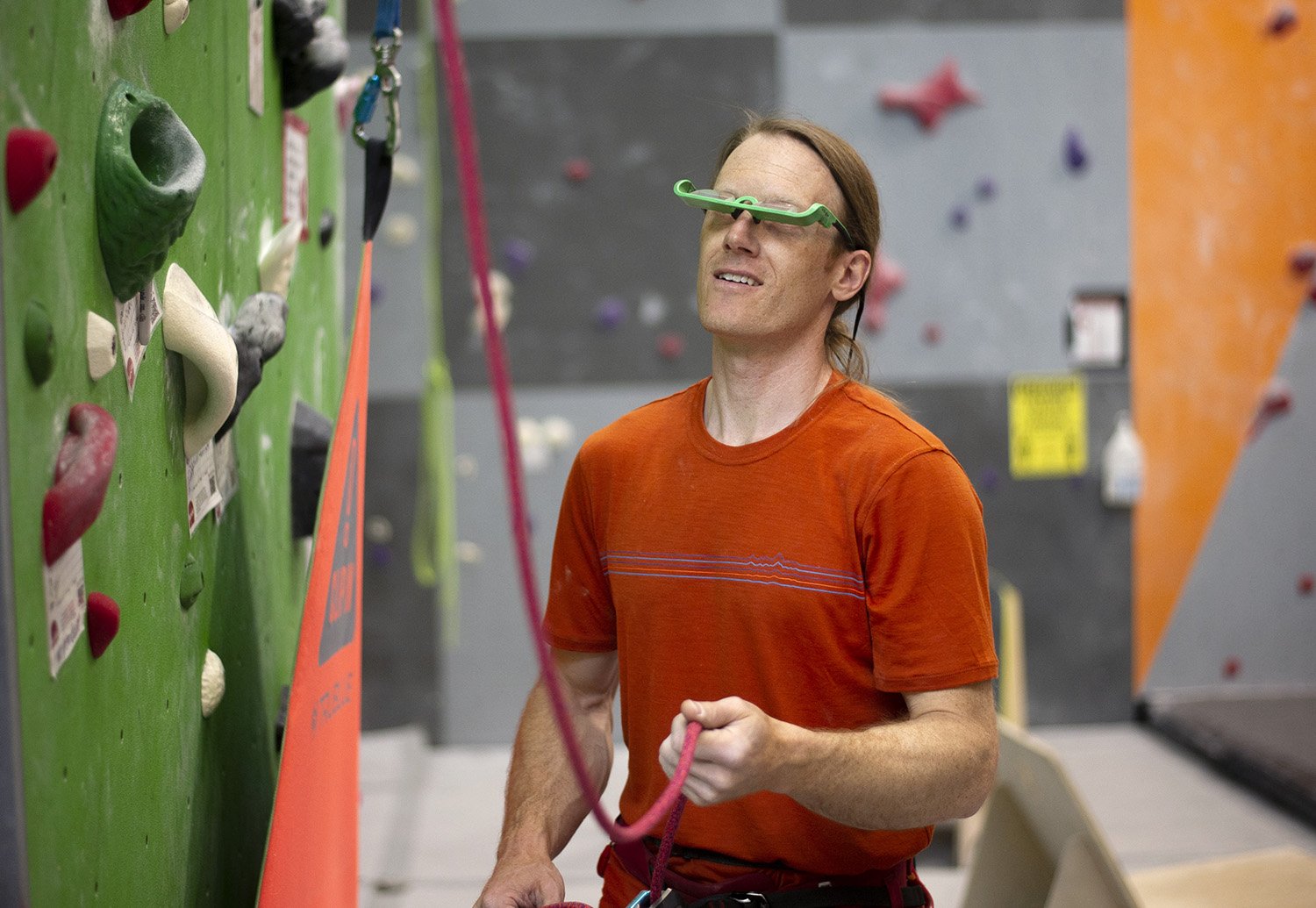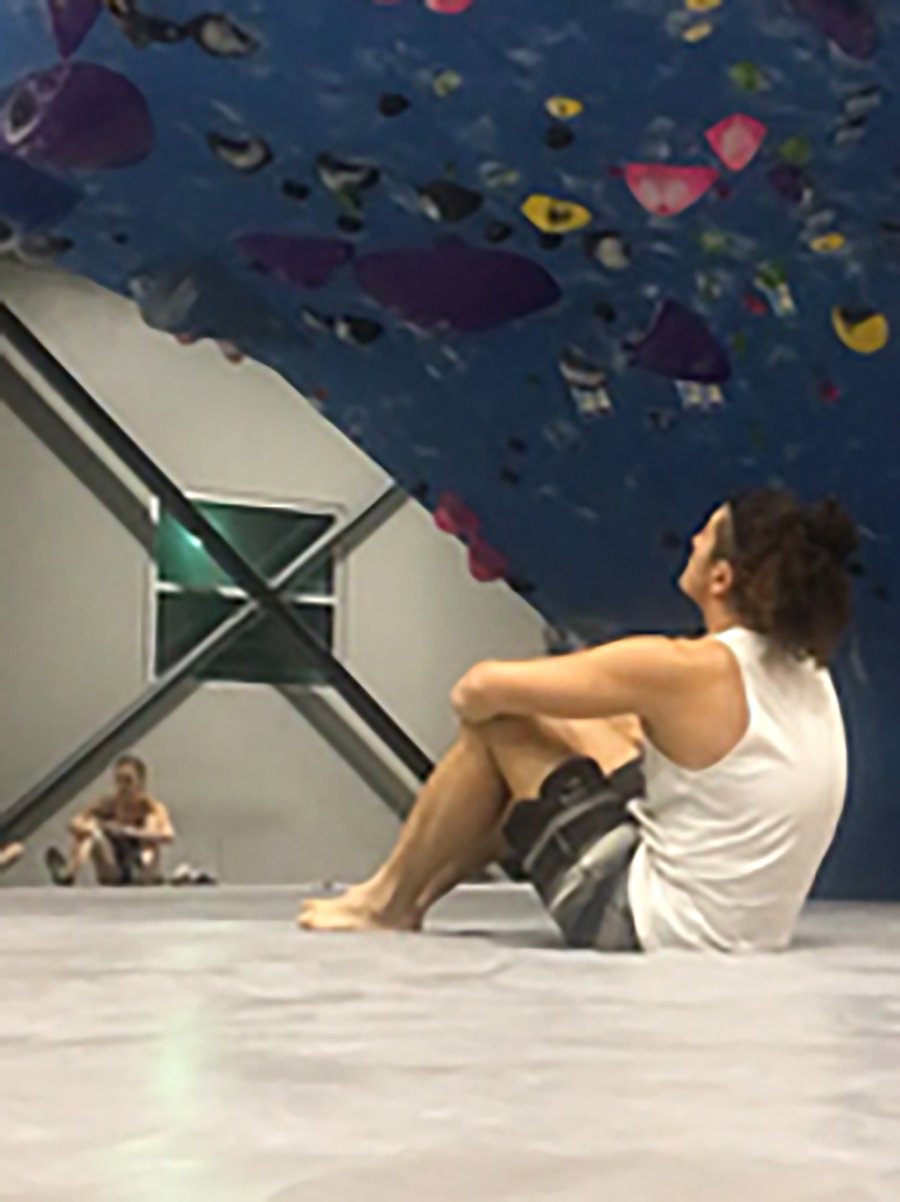Avoid the Rock Climbing Hunchback pt. 4: Application
The last phase of the rock rehab pyramid is to correct the mechanics of rock climbing and educate the climber on their posture. In this stage, continue performing the mobility and strength exercises in addition to getting back on the wall with correct alignment and awareness of your posture on the wall.
Below, the image to the left shows an extreme case of neck extension which can be corrected with increasing the external rotation range of motion of the lower extremity, and by keeping the hip and center of gravity closer to the wall. The image to the right is an example of this correction.
Below, the image to the left shows an excessive thoracic kyphosis that can be corrected by engaging the muscles that you have strengthened in the thoracic spine with the previous exercises. Pull the shoulder blades together, towards the midline (medially) and down and back as shown in the picture to the right.
In addition, you must pay more attention to the belaying posture and maintaining correct alignment while giving a belay. In order to prevent neck and back pathology, you can use belay glasses, which will allow you to keep the neck in neutral while watching and belaying your partner. The image shown below is an example of belay glasses.
Another contributing factor to the climber’s hunch back is when the climbers are watching another climber bouldering. The climber is typically in a seated position while curving the upper spine, thereby compensating by bending the neck back excessively to be able to look up. The image to the left illustrates an incorrect posture, while the image to the right is an example of the correct posture.
THE RESEARCH
Poor Climbing Posture
High grade climbers usually suffer from back pain pathology. This study is related to climber hunch back, “Form and Mobility of the Thoracolumbar Spine Leading to Postural Adaptations in Male High Ability Rock Climbers.” This condition is directly correlated with poor climbing posture and the adaptations that come from muscle strength and length imbalances. In this cohort study, the spine of 80 healthy asymptomatic male sport climbers (SC) were analyzed. The advanced group trained regularly (9.8 ± 4.3 hr. /wk.), their mean climbing ability was 9.7 ± 0.6, and they had been climbing for 14.1 ± 6.6 years. The control group consisted of 34 recreational climbers (RC) who climbed less frequently (3.4 ± 2.0 hr. /wk.). Their climbing ability was 6.0 ± 0.9, and they had been climbing for a duration of 4.9 ± 4.5 years.
In order to analyze the spine, researchers looked at the thoracic and lumbar spine in sagittal plane and used a Spinal Mouse, which is a non-invasive procedure and does not require radiation exposure. The results indicated that the kyphosis angle (thoracic spine hunch) in sports climbers was greater than the recreational climbers. In addition, lumbar lordosis was greater in SC compared to RC. Next, the SC group was subdivided to SC moderate (17 participants) and SC top level (29 participants). In this analysis, the thoracic kyphosis and lumbar lordosis angles were significantly greater in the top-level SC compared to moderate level SC. The result confirmed that climber’s hunch back was characterized with increased thoracic kyphosis and increased lumbar lordosis. The excessive kyphosis was influenced by shortened pectoral muscles and the climbing ability was strongly correlated to the postural adaptations.
Excessive kyphosis is the cause of many impairments, such as blockages of the small intervertebral joints (reversible facet joint hypomobility), headaches, numb fingers and shoulder disorders. Each of these conditions could be a result of decreased blood flow associated with the postural adaptations of a “climber’s back”. The presence of numb fingers, shoulder disorders and other conditions already described are commonly found in thoracic hyper kyphosis with causation due to a thoracic outlet syndrome.
Förster R, Penka G, Bösl T, Schöffl VR. Climber’s back – Form and mobility of the thoracolumbar spine leading to postural adaptations in male high ability rock climbers. Int J Sports Med. 2009;30(1):53-59. doi:10.1055/s-2008-1038762.
Weaknesses of this Study:
There were no females in the study
There was nothing mentioned about bouldering and traditional climbing
The length of pec minor was not measured
There was nothing mentioned about cervical spine
The sample population was too small to reach clinical significance
Could use cobb angle with X-ray to assess the spine
Strengths of this Study:
The study is clinically reproducible
The study used non-invasive Spinal Mouse for analysis of the spine angles
See a Doctor of Physical Therapy at Evolution
By reading this article, you can self-treat a climber hunch, but by having a consultation with a doctor of physical therapy, you can improve rehabilitation and have an individualized plan. Doctors of physical therapy at Evolution Physical Therapy will not only design customized therapeutic exercises for you, but also specialize in manual interventions that would decrease the time of rehabilitation. Additionally, doctors of physical therapy are movement specialists that can analyze the biomechanics of any sport and make corrections based on the analysis. Seeing a doctor of physical therapy is highly recommended for the best intervention geared specifically towards your needs.
Reach out for more guidance on developing a customized training program that will maximize your rehab, minimize the risk of injury and overall elevate your rock climbing or individual sport. Email bo@evolution-pt.com for specific questions, or click the link below to request an appointment!
Thank you to Evolution Physical Therapy for sharing this article.








